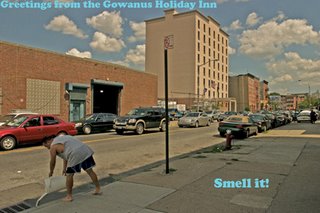 For a while now I've been mulling over the hollowness of "You"-- the purported prime mover in the consumer chain. Design your own personal sneaker, Hummer, pizza. Express your personality through the oxymoronic doublespeak of "mass customization." The escalating illusion is that now, with technology at one's fingertips, the power is in your hands. As with niche marketing, innovations with just your slice of demographic in mind, one is told many times over, "you deserve it." You're so busy/ important/overworked/ worthy, you deserve 500 channels of 24-hr HD sports (or whatever), you deserve soup in a go-cup, a good night's sleep with AmbienCR. Here's a fat-free fudge-dipped caramel bite with extra calcium created expressly for your over-40 bones. Coach or L.L. Bean in your Lincoln Navigator? Your choice! This proliferation of specious choice-- the so-called American ethos of individualism ("freedom") distorted through a lens of consumption. All of this disingenuous catering (pandering?) to "you." And then last week Time made "you" the Person of the Year in one of the most oleaginous essays I've read recently:
For a while now I've been mulling over the hollowness of "You"-- the purported prime mover in the consumer chain. Design your own personal sneaker, Hummer, pizza. Express your personality through the oxymoronic doublespeak of "mass customization." The escalating illusion is that now, with technology at one's fingertips, the power is in your hands. As with niche marketing, innovations with just your slice of demographic in mind, one is told many times over, "you deserve it." You're so busy/ important/overworked/ worthy, you deserve 500 channels of 24-hr HD sports (or whatever), you deserve soup in a go-cup, a good night's sleep with AmbienCR. Here's a fat-free fudge-dipped caramel bite with extra calcium created expressly for your over-40 bones. Coach or L.L. Bean in your Lincoln Navigator? Your choice! This proliferation of specious choice-- the so-called American ethos of individualism ("freedom") distorted through a lens of consumption. All of this disingenuous catering (pandering?) to "you." And then last week Time made "you" the Person of the Year in one of the most oleaginous essays I've read recently:And we didn't just watch, we also worked. Like crazy. We made Facebook profiles and Second Life avatars and reviewed books at Amazon and recorded podcasts. We blogged about our candidates losing and wrote songs about getting dumped. We camcordered bombing runs and built open-source software. ...Who has that time and that energy and that passion? The answer is, you do. And for seizing the reins of the global media, for founding and framing the new digital democracy, for working for nothing and beating the pros at their own game, TIME's Person of the Year for 2006 is you.
What about me? Despite both designations having to do with the individual, presumed solipsism, and implied atomization, the "Me" of the Me Generation (I believe it was Tom Wolfe who christened the 70s the Me Decade, with "generation" being an extrapolation from that.) strikes me as a different concept. At its most elementary level, the term is subjective: me, I. And I read the term, at very least, as active --seeking out self-definition, though not necessarily through consumption. This "You" moment conveys an object observed and defined by others: what you buy, what you own, your 'audience.' The you as consumer defined by age/income/race/ demographic...
---
I only just recently saw the Frontline show "The Persuaders" on the web, although the episode is more than 2 years old. It is a disturbing and utterly fascinating overview of the current culture of marketing and advertising and its societal influences. The web site for the episode is dense with interviews, transcripts, commentary--it is a must. Someone there (cant remember which person sums it up) distilled for me what had been ill-defined complaints and ravings: the danger of an atomized populace in a completely immersive, consumer-driven society is that there is no longer a recognition of "the common good," or civic duty; democracy itself comes apart. Media critic Mark Crispin Miller (whom I had not heard of before) delivers some of the most devastating commentary.
Consumers are feeders. All consumers do is consume. ...They're being manipulated to think only about the grass that they're chewing and nothing else, and manipulated into thinking about ways to get more grass. They're not operating on a sufficiently high level to participate in a democracy…---
So the Burger King "have it your way" campaign of circa 1974 (?) was a brilliant precursor to the mass customization model...











